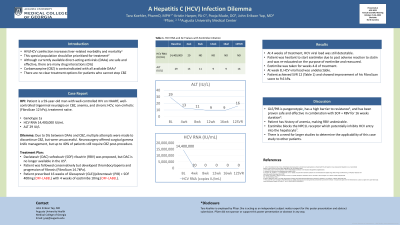Back


Poster Session D - Tuesday Morning
Category: Liver
D0603 - A Hepatitis C (HCV) Infection Treatment Dilemma
Tuesday, October 25, 2022
10:00 AM – 12:00 PM ET
Location: Crown Ballroom

Has Audio

Tara Koehler, PharmD, MPH
Augusta University Medical Center
Augusta, GA
Presenting Author(s)
Tara Koehler, PharmD, MPH1, Kristin Harper, PA-C1, Pooja Mude, DO2, Praneeth Kudaravalli, MD1, John Erikson L. Yap, MD2
1Augusta University Medical Center, Augusta, GA; 2Augusta University Medical College of Georiga, Augusta, GA
Introduction: HIV/HCV coinfection increases liver-related morbidity and mortality. This special population should be prioritized for treatment. Currently available direct-acting antivirals (DAAs) are safe and effective, but there are many drug interactions (DIs) to consider. Carbamazepine (CBZ) is contraindicated with all available DAAs. Patients that require treatment for HCV but cannot stop CBZ do not have a clear treatment option. Patients may be transitioned to newer antiepileptics that do not have the same contraindications, but some patients are unwilling or unable to change medications.
Case Description/Methods: Patient is a 59-year-old man with well-controlled HIV on HAART, well-controlled trigeminal neuralgia on CBZ, anemia, and non-cirrhotic (FibroScan 12 kPa), treatment naïve, chronic HCV genotype 1a. Due to DIs between DAAs and CBZ, multiple attempts were made to discontinue CBZ but were unsuccessful. Neurosurgery offered surgical gamma knife management, but up to 40% of patients still require CBZ post-procedure. An initial plan for daclatasvir (DAC)-sofosbuvir (SOF)-ribavirin (RBV) was proposed, but DAC is no longer available in the US. Patient was followed conservatively but developed thrombocytopenia and progression of fibrosis (FibroScan 14.7kPa). Given worsening liver condition, shared decision-making was performed, and patient completed 16 weeks of Glecaprevir (GLE)/pibrentasvir (PIB) + SOF 400mg with 4 weeks of ezetimibe 10mg stopping when the viral load was undetectable. Patient was instructed to start the ezetimibe with the GLE/PIB + SOF but was hesitant to take it due to adverse reaction to statins in the past. At 4 weeks of treatment, HCV viral load was still detectable. Patient was re-educated on the purpose of the ezetimibe and reassured it was not a statin. He took it from week 4-8 of treatment. At week 8, HCV viral load was undetectable. Patient achieved SVR 12 and showed improvement of his FibroScan score to 9.6 kPa.
Discussion: GLE/PIB is pangenotypic, has a high barrier to resistance, and has been proven safe and effective in combination with SOF + RBV in MAGELLAN 3 for 16 weeks duration. Patient has history of anemia, making RBV undesirable. Ezetimibe blocks the NPC1L receptor which potentially inhibits HCV entry into the hepatocyte. HCV relies on cell-to-cell transmission, so we chose to add ezetimibe 10mg daily until HCV not detected. There is a need for larger studies to determine the applicability of this case study to other patients.
Disclosures:
Tara Koehler, PharmD, MPH1, Kristin Harper, PA-C1, Pooja Mude, DO2, Praneeth Kudaravalli, MD1, John Erikson L. Yap, MD2. D0603 - A Hepatitis C (HCV) Infection Treatment Dilemma, ACG 2022 Annual Scientific Meeting Abstracts. Charlotte, NC: American College of Gastroenterology.
1Augusta University Medical Center, Augusta, GA; 2Augusta University Medical College of Georiga, Augusta, GA
Introduction: HIV/HCV coinfection increases liver-related morbidity and mortality. This special population should be prioritized for treatment. Currently available direct-acting antivirals (DAAs) are safe and effective, but there are many drug interactions (DIs) to consider. Carbamazepine (CBZ) is contraindicated with all available DAAs. Patients that require treatment for HCV but cannot stop CBZ do not have a clear treatment option. Patients may be transitioned to newer antiepileptics that do not have the same contraindications, but some patients are unwilling or unable to change medications.
Case Description/Methods: Patient is a 59-year-old man with well-controlled HIV on HAART, well-controlled trigeminal neuralgia on CBZ, anemia, and non-cirrhotic (FibroScan 12 kPa), treatment naïve, chronic HCV genotype 1a. Due to DIs between DAAs and CBZ, multiple attempts were made to discontinue CBZ but were unsuccessful. Neurosurgery offered surgical gamma knife management, but up to 40% of patients still require CBZ post-procedure. An initial plan for daclatasvir (DAC)-sofosbuvir (SOF)-ribavirin (RBV) was proposed, but DAC is no longer available in the US. Patient was followed conservatively but developed thrombocytopenia and progression of fibrosis (FibroScan 14.7kPa). Given worsening liver condition, shared decision-making was performed, and patient completed 16 weeks of Glecaprevir (GLE)/pibrentasvir (PIB) + SOF 400mg with 4 weeks of ezetimibe 10mg stopping when the viral load was undetectable. Patient was instructed to start the ezetimibe with the GLE/PIB + SOF but was hesitant to take it due to adverse reaction to statins in the past. At 4 weeks of treatment, HCV viral load was still detectable. Patient was re-educated on the purpose of the ezetimibe and reassured it was not a statin. He took it from week 4-8 of treatment. At week 8, HCV viral load was undetectable. Patient achieved SVR 12 and showed improvement of his FibroScan score to 9.6 kPa.
Discussion: GLE/PIB is pangenotypic, has a high barrier to resistance, and has been proven safe and effective in combination with SOF + RBV in MAGELLAN 3 for 16 weeks duration. Patient has history of anemia, making RBV undesirable. Ezetimibe blocks the NPC1L receptor which potentially inhibits HCV entry into the hepatocyte. HCV relies on cell-to-cell transmission, so we chose to add ezetimibe 10mg daily until HCV not detected. There is a need for larger studies to determine the applicability of this case study to other patients.
Disclosures:
Tara Koehler: Pfizer – Employee, This case was done prior to me joining Pfizer. Pfizer did not support or sponsor this abstract in any way. I am acting as an independent SME.
Kristin Harper indicated no relevant financial relationships.
Pooja Mude indicated no relevant financial relationships.
Praneeth Kudaravalli indicated no relevant financial relationships.
John Erikson Yap indicated no relevant financial relationships.
Tara Koehler, PharmD, MPH1, Kristin Harper, PA-C1, Pooja Mude, DO2, Praneeth Kudaravalli, MD1, John Erikson L. Yap, MD2. D0603 - A Hepatitis C (HCV) Infection Treatment Dilemma, ACG 2022 Annual Scientific Meeting Abstracts. Charlotte, NC: American College of Gastroenterology.
